NVIDIA GeForce GTX 780 Review: The New High End
by Ryan Smith on May 23, 2013 9:00 AM ESTCompute
Jumping into compute, we should see a mix of results here, with some tests favoring the GK110 based GTX 780’s more compute capable design, while other tests will punish it for not being a fast FP64 card like GTX Titan.
As always we'll start with our DirectCompute game example, Civilization V, which uses DirectCompute to decompress textures on the fly. Civ V includes a sub-benchmark that exclusively tests the speed of their texture decompression algorithm by repeatedly decompressing the textures required for one of the game’s leader scenes. While DirectCompute is used in many games, this is one of the only games with a benchmark that can isolate the use of DirectCompute and its resulting performance.
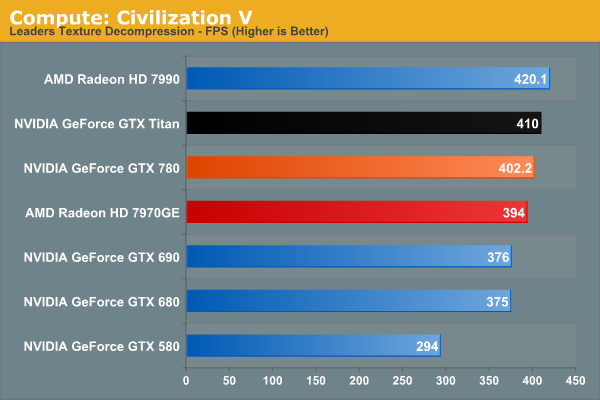
Civilization V’s DirectCompute performance is looking increasingly maxed out at the high end. At 402fps the GTX 780 may as well be tied with GTX Titan. On the other hand it’s a reminder that while we don’t always see NVIDIA do well in our more pure compute tests, it can deliver where it matters for games with DirectCompute.
Our next benchmark is LuxMark2.0, the official benchmark of SmallLuxGPU 2.0. SmallLuxGPU is an OpenCL accelerated ray tracer that is part of the larger LuxRender suite. Ray tracing has become a stronghold for GPUs in recent years as ray tracing maps well to GPU pipelines, allowing artists to render scenes much more quickly than with CPUs alone.
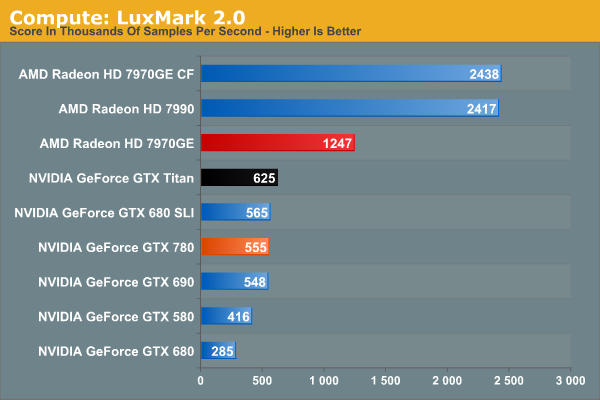
NVIDIA has never done well at LuxMark, and GTX 780 won’t change that. It’s greatly faster than GTX 680 and that’s about it. Kepler parts, including GK110, continue to have trouble with our OpenCL benchmarks, as evidenced by the fact that GTX 780 doesn’t beat GTX 580 by nearly as much as the generational improvements should lead to. GK110 is a strong compute GPU, but not in ways that LuxMark is going to benefit.
Our 3rd benchmark set comes from CLBenchmark 1.1. CLBenchmark contains a number of subtests; we’re focusing on the most practical of them, the computer vision test and the fluid simulation test. The former being a useful proxy for computer imaging tasks where systems are required to parse images and identify features (e.g. humans), while fluid simulations are common in professional graphics work and games alike.
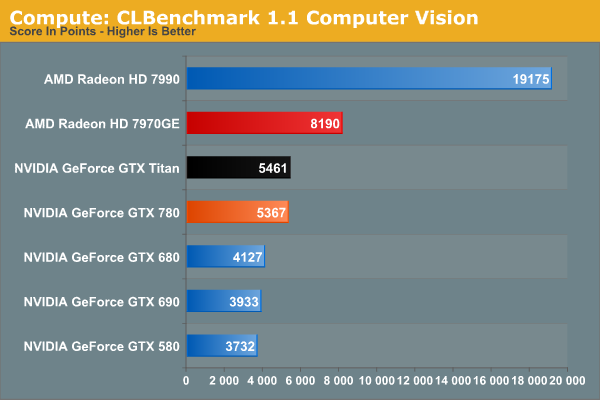
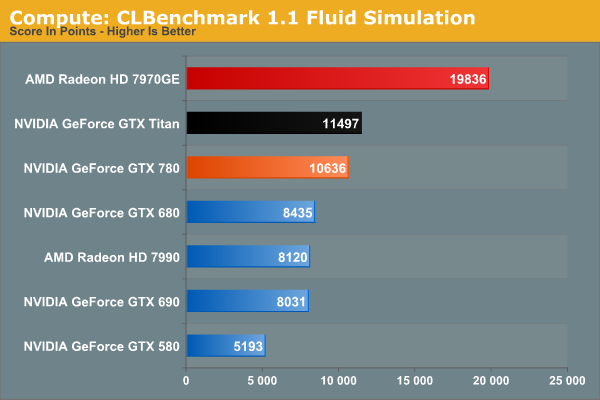
GTX 780 still struggles some at compute with CLBenchmark, but less so than with LuxMark. 7970GE is the clear winner here in both tests, while GTX 780 stays remarkably close to GTX Titan in performance. The fluid simulation in particular makes GTX 780 look good on a generational basis, more than doubling GTX 580’s performance.
Moving on, our 4th compute benchmark is FAHBench, the official Folding @ Home benchmark. Folding @ Home is the popular Stanford-backed research and distributed computing initiative that has work distributed to millions of volunteer computers over the internet, each of which is responsible for a tiny slice of a protein folding simulation. FAHBench can test both single precision and double precision floating point performance, with single precision being the most useful metric for most consumer cards due to their low double precision performance. Each precision has two modes, explicit and implicit, the difference being whether water atoms are included in the simulation, which adds quite a bit of work and overhead. This is another OpenCL test, as Folding @ Home has moved exclusively to OpenCL this year with FAHCore 17.

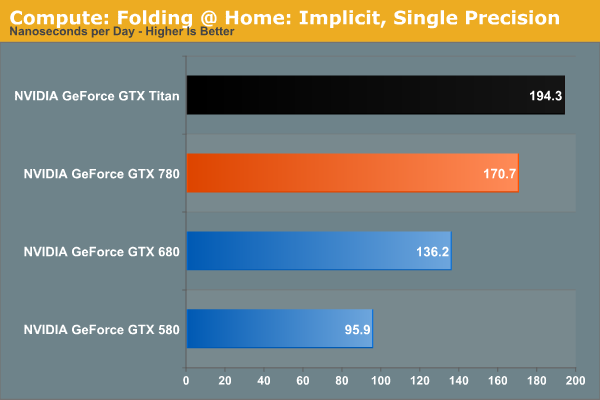
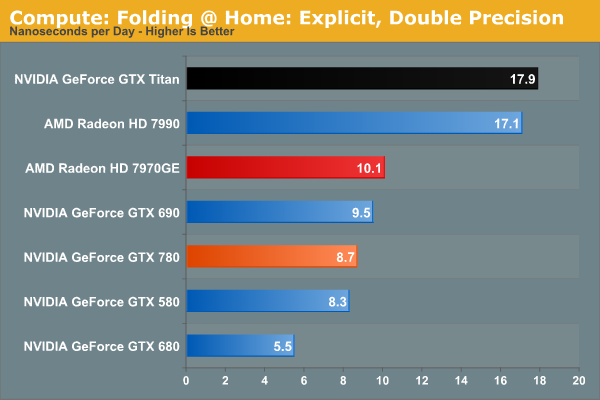
The Folding@Home group recently pushed out a major core update(FAHBench 1.2.0), which we’ve rerun on a number of cards and is reflected in our results. Unfortunately this version also broke single precision implicit on AMD GPUs and AMD’s latest drivers, so we only have NVIDIA GPUs for that section.
In any case, despite the fact that this is an OpenCL benchmark this is one of the cases where NVIDIA GPUs do well enough for themselves in single precision mode, with GTX 780 surpassing 7970GE, and falling behind only GTX Titan and the 7990. GTX 780 doesn’t necessarily benefit from GK110’s extra compute functionality, but it does see a performance improvement over GTX 680 that’s close to the theoretical difference in shader performance. Meanwhile in double precision mode, the lack of an uncapped double precision mode for GTX 780 means that it brings up the bottom of the charts compared to Titan and its 1/3 FP64 rate. Compute customers looking for a bargain NVIDIA card (relatively speaking) will need to stick with Titan.
Wrapping things up, our final compute benchmark is an in-house project developed by our very own Dr. Ian Cutress. SystemCompute is our first C++ AMP benchmark, utilizing Microsoft’s simple C++ extensions to allow the easy use of GPU computing in C++ programs. SystemCompute in turn is a collection of benchmarks for several different fundamental compute algorithms, as described in this previous article, with the final score represented in points. DirectCompute is the compute backend for C++ AMP on Windows, so this forms our other DirectCompute test.
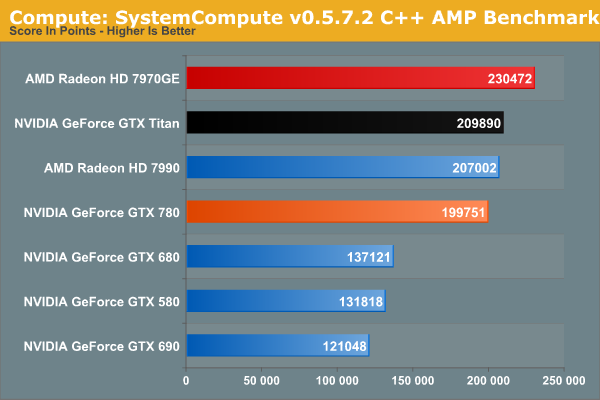
SystemCompute shows very clear gains over both the GTX 680 and GTX 580, while trailing the GTX Titan as expected. However like Titan, both trail the 7970GE.










155 Comments
View All Comments
SymphonyX7 - Thursday, May 23, 2013 - link
*mildly/narrowly trailing the GTX 680chizow - Thursday, May 23, 2013 - link
AMD released some significant driver updates in ~Oct 2012, branded "Never Settle" drivers that did boost GCN performance significantly, ~10-20% in some cases where they were clearly deficient relative to Nvidia parts. It was enough to make up the difference in a lot of cases or extend the lead to where the GE is generally faster than the 680.On the flipside, some of AMD's performance claims, particularly with CF have come under fire due to concerns about microstutter and frame latency, ie. the ongoing runtframe saga.
Vayra - Thursday, May 23, 2013 - link
Drivers possibly?kallogan - Thursday, May 23, 2013 - link
High end overpriced gpu again ! Next !wumpus - Thursday, May 23, 2013 - link
Except that the 780 is nothing more than a Titan with even more cuda performance disabled. Presumably, they are expecting to get Titan sales to people interested in GPU computing, if only for geeklust/boasting.wumpus - Thursday, May 23, 2013 - link
My above comment was supposed to be a reply. Ignore/delete if possible.ifrit39 - Thursday, May 23, 2013 - link
Shadow Play is the most interesting news here. It costs a not-insignificant amount of money to buy a decent capture card that will record HD video. This is a great alternative as it requires no extra hardware and has little CPU/GPU overhead. Anything that ends up on the net will be compressed by youtube or other service anyway. I can't wait to remove fraps and install shadow play.ahamling27 - Saturday, May 25, 2013 - link
Fraps isn't the best, but they somehow have the market cornered. Look up Bandicam, I use it exclusively and I get great captures at a fraction the size. Plus they aren't cut up into 4 gig files. It has at least 15x more customization like putting watermarks in your capture or if you do like to segment your files you can have it do that at any size or time length you want. Plus you can record two sound sources at once, like your game and mic, or your game and whatever voice chat software you use.Anyway, I probably sound like I work for them now, but I can assure you I don't. This Shadow Play feature is definitely piquing my interest. If it's implemented wisely, it might just shut all the other software solutions down.
garadante - Thursday, May 23, 2013 - link
There were two things that instantly made me dislike this card, much as I've liked Nvidia in the past: completely disabling the compute performance down to 600 series levels which was the reason I was more forgiving towards AMD in the 600/7000 series generation, and that they've priced this card at $650. If I remember correctly, the 680 was priced at $500-550 at launch, and that itself was hard to stomach as it was and still is widely believed GK104 was meant to be their mid-range chip. This 780 is more like what I imagined the 680 having been and if it launched at that price point, I'd be more forgiving.As it is... I'm very much rooting for AMD. I hope with these new hires, of which Anandtech even has an article of their new dream team or some such, that AMD can become competitive. Hopefully the experience developers get with their kind-of-funky architecture with the new consoles, however underwhelming they are, brings software on the PC both better multithreaded programming and performance, and better programming and performance to take advantage of AMD's module scheme. Intel and Nvidia both need some competition so we can get this computer hardware industry a bit less stagnated and better for the consumer.
EJS1980 - Tuesday, May 28, 2013 - link
The 680 was $500 at launch, and was the main reason why AMD received so much flak for their 7970 pricing. At the time it launched, the 680 blew the 7970 away in terms of gaming performance, which was thee reason AMD had to respond with across the board price drops on the 7950/70, even though it took them a few months.